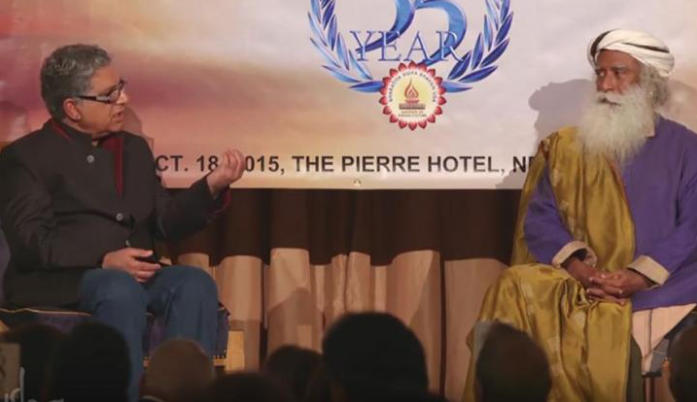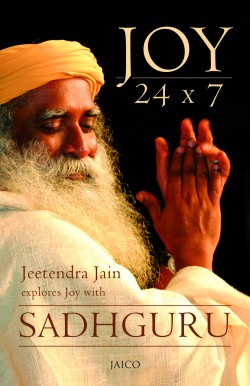Discussion between Deepak Chopra and Sadhguru about Ancient wisdom in modern times in Bharath Vidhya Bhavan, New York, moderated by Chandrika Tandon.
Recently Sadhguru and Deepak Chopra were in conversation on the occasion of Bharath Vidhya Bhavan‘s 35th year anniversary gala. Bharat Vidhya Bhavan was originally founded in India by the visionary Dr. K.M.Munshi with the blessing of Mahatma Gandhi in order to revive the true Indian culture, heritage and education suppressed for centuries by foreign powers. The non-profit organization promotes the rich traditions of Indian art forms, music, dance, drama, painting and films, as well as Indian languages, literature and studies of religion and different systems of philosophy. Best-selling recording artist, composer, producer and humanitarian A.R. Rahman was also in attendance, receiving honors for his worldwide contribution to music and humanity. Rahman’s award-winning works for film and stage are noted for integrating Eastern classical music with electronic music, world music and traditional orchestral arrangements. Chandrika Tandon, Grammy-nominated contemporary world musician of Soul Chants Music, offered a performance and also moderated a lively interactive discussion between Chopra and Sadhguru on “Ancient Wisdom in Modern Times”.
What encompassed the lively discussion between the two? The conversation between the Seer and the Scientist allowed the same truth to be explored from different angles. That is, how can we know truth beyond the mind and thought process? With regard to using the logical mind to explore truth, Sadhguru shares the following:
Right now the logical dimension of thought is filtering life through the intellect. The logical process has become so dominant simply because right now perception is limited to the five senses. The very nature of sense perception is such that it always perceives everything in bits and pieces. It always divides everything into at least two. It never perceives anything as one. If you can see one side of your hand you cannot see the other side. This is so even if you take a grain of sand. If you perceive one part of it, you do not perceive another. The moment you perceive everything through the five sense organs, the world gets divided. Only when there is a division, there is logic. If there is only one, there is no logic. The foundation of the logical mind is in dividing the world. If you do not divide existence, you cannot employ your logic. Sense perception and logical thinking are directly connected.They are complementary to each other. That dimension of truth, which cannot be boxed into your logical mind, is being labeled “mystical.” When you say, “we want to explore mysticism,” you are saying that you are willing to go beyond your present levels of understanding and experience and look for the truth. Our logical minds will not be of use to us here. Only what has been fed to you through the filters of your five sense organs is the content of your logic. And these sense organs are not reliable.
Today, neuroscientists are going to great lengths to prove that almost everything that you have known as true until now is false – what you see, hear, smell and taste is not true. It is a big deception. Nothing is the way it seems. Physicists were telling you this to an extent, but neuroscientists are now confirming it to you. They can prove to you with experimentation that everything that you see around you – the shapes and forms, colors and sizes – none of this is true. I think, way back, Indian mystics always said everything is maya (illusion).
Both Sadhguru and Deepak Chopra agree that perception through the sense organs is very limited. Further, Deepak Chopra expounds:
Our sense of reality is different from its mathematical basis as given by physical theories. Although nature at its deepest level is quantum mechanical and nonlocal, it appears to our minds in everyday experience as local and classical. Since the same laws should govern all phenomena, we propose this difference in the nature of perceived reality is due to the principle of veiled nonlocality that is associated with consciousness. Veiled nonlocality allows consciousness to operate and present what we experience as objective reality. In other words, this principle allows us to consider consciousness indirectly, in terms of how consciousness operates. We consider different theoretical models commonly used in physics and neuroscience to describe veiled nonlocality. Furthermore, if consciousness as an entity leaves a physical trace, then laboratory searches for such a trace should be sought for in nonlocality, where probabilities do not conform to local expectations.
Our senses gives a very unreliable and limited view of reality. Is the physical world we see is real? Our world corresponds to our nervous system. Our world is species specific, it is a perceptual experience and it is influenced by many things.What about science? Does that give us an accurate description of the world? It can not, as science is an extension of our senses, it only can give a human perception of the world. An accurate description of the world around us need to be independent of the observer. Infinite possibilities is the only reality. Maya means illusion and the measurement of infinity into finite forms.
And Sadguru takes it one step further into pragmaticism:
Our perception through the sense organs is very limited. What we refer to as the mystical is that dimension of life which we are unable to perceive through our sense organs or deduce through our logical process. When our logic fails, anything that does not look logical becomes mysterious. Right now because your perception is limited to the five senses, the mystical can only be a fantastic story that you either believe or disbelieve. I want you to understand the difference between the mystical and the magical. “Harry Potter” is selling in millions today. That’s not mysticism, that’s magic; and that’s different. When we seek to experience the mystical, we are not looking for entertainment. We are looking for a solution to our lives.
Below is the entire conversation:





